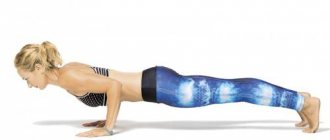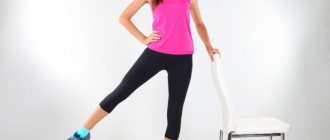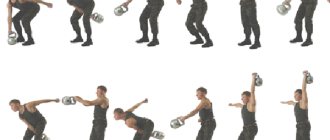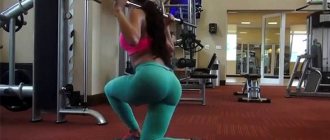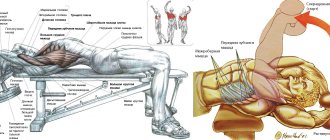Execution technique
Step 1:
Stand straight and bring your feet together: your big toes should touch each other, you can spread your heels a little if necessary. Roll onto your heels, lift your metatarsals and spread your toes, then gently return them to the mat, extending your toes along the mat.
The entire area of your feet should be pressed against the mat - try to fit even the spaces between your toes and metatarsus into the mat. Roll your feet back and forth, left and right until you feel that absolutely the entire surface of your foot is pressed to the floor.
Step 2:
Tighten and pull up your thigh muscles, pull up your knees.
Push through the inside of your ankles to tighten your inner thighs. Curl your upper thighs slightly inward. Also tuck your tailbone inward (towards the floor), while raising your pubis towards your navel.
Step 3:
Rotate your shoulders in a downward circular motion. Press your shoulders down, releasing and lengthening your neck. Pull your upper chest up without lifting your lower ribs.
The arms are calmly extended along the body, but are in good shape and do not hang down. The fingers are gathered together.
Step 4:
Keep your head straight. Imagine that you are being pulled up by the top of your head. The chin should be perpendicular to the floor - not down or tilted back. The throat is soft, the tongue in the mouth is relaxed.
Step 5:
Hold the pose for 30 seconds to 1 minute, breathing lightly. Tadasana is usually the starting asana for all standing poses. But it is useful to practice the mountain pose on your own.
Modification
Option 1
This position is called swinging palm pose, or tree bending in the wind pose, or Tiryaka tadasana. It is a standing side or side bending asana with a gentle stretching effect. This is the only asana with spinal bending that does not require outside assistance. Movement of 2-10 degrees at each individual vertebral joint produces lateral bending of all joints together up to 90 degrees.
This asana, like Tadasana, but to a lesser extent stretches the muscles and joints of the entire spine.
It improves growth in children. Tiryaka tadasana stretches and contracts the paravertebral or trunk muscles that support the spine. When the muscles on the right side are compressed, the muscles on the left side are stretched and vice versa, bending the spine laterally. Alternative stretching and contracting eliminates excess muscle tone and fatigue in those who are forced to remain in the same position for long periods of time, such as students, programmers and office workers.
- Place your feet on the floor, 15 cm apart.
- Inhale deeply and raise your hands up, interlocking your fingers and pointing the inside of your palms upward.
- Try to rise up onto your toes, lifting your heels. Feel the stretch from your toes to your fingers.
- Maintain a tight feeling and tilt your torso to the right. Then left. Hands clasped in a lock continue the line of the body.
- Maintain the pose as long as your breathing is slow and deep.
- Return to the starting position while exhaling deeply.
- You can do the number of repetitions as you wish, after some rest and relaxation.
Option 2
- Lie on the floor with your back on the ground.
- Stretch your arms along your body, palms facing down.
- Try to keep your legs, spine, neck and head on the same line. Inhale and slowly lift both arms up and place them behind your head.
- Your arms should be parallel to each other, palms facing up. Keep your breathing even and calm.
- Now stretch your arms and legs in opposite directions as far as possible.
- Try to keep your legs and arms straight (do not bend). Exhaling, slowly lower your arms to the starting position.
- Repeat four times and try to increase the time spent in the asana.
In Iyengar yoga, palm pose is performed by raising the arms above the head or holding them at the sides, towards the floor.
In Vinyasa yoga, Tadasana is performed while standing with the hands folded in Namaste.
In Ashtanga yoga, Tadasana is the beginning and end of Surya Namaskar. Various variations of Tadasana can be seen in videos that are widely available on the Internet.
Variations
- You can change the position of your hands in various ways:
A . stretch your arms up, perpendicular to the floor and parallel to each other, palms facing inward (Urdhva Hastasana - standing arm extension);
B. _ interlace your fingers, extend your arms straight in front of your body, turning your palms away from you, then stretch your arms up, perpendicular to the floor, so that your palms are facing the ceiling (Talasana - Palm Tree Pose);
IN . Cross your arms behind your back, holding each elbow with the opposite hand (be sure to switch arms and repeat the asana).
- Light version
If you find it difficult to maintain balance, place your feet a short distance apart. You can perform the asana near a wall to control your back. Stand with your back to the wall, touching it with your heels, sacrum and shoulder blades.
Additional Tips
People who are performing the asana for the first time can do it while standing against a wall: this will make it easier to develop coordination and control the correct position and distribution of body weight. At first, you can touch the wall with the back of the shoulder girdle, crown, shins, shoulder blades and sacrum. Tips that will help you perform Tadasana correctly:
- Although the asana requires the simultaneous contact of the heels and big toes, the implementation of this rule directly depends on the structural features of the feet. Therefore, some people are allowed this option: the heels are a short distance from each other, but the shin bones should touch each other.
- Some people have difficulty with the correct positioning of their fingers, with the thumbs closed and the others spread as wide as possible. To make it easier to fulfill this requirement, you can close your big toes and raise your feet, focusing on your heels. In this position, the fingers will stretch out. After this, you need to roll down to the floor, fixing your fingers and pressing them tightly to the surface.
- Body weight is evenly distributed over the entire surface of both feet. The same load should fall on the inner and outer edges of the foot, on the front and back of it.
- To properly distribute the load, you need to press the inside of your heel harder against the floor (the place where the dome of your foot begins).
- Full concentration on the state of your body and movements will help you feel how your body weight is evenly and correctly distributed over all points of your feet.
- The knee joints (the outer part) should be in an open position, while the inner part should be pulled up as much as possible.
- Raising the chest, you need to include the feet in the work, at the same time expand the collarbone, open the shoulders, and hide the shoulder blades inward towards the shoulder girdle. Leave the bottom row of ribs without movement.
To make the asana easier to perform, it is recommended to do a light warm-up before it, this will help tone all the muscles. Warm muscles are lighter and easier to control.
The most difficult thing in this pose is not so much to position the feet correctly, but to maintain correct breathing throughout the entire asana. You need to breathe evenly, slowly and deeply.
How to do it?
Even as a child, you are taught to walk with a straight back and maintain good posture. These are the first makings of tadasana. The asana itself is performed in a standing position. It helps restore breathing, calms the mind, and relaxes muscles.
To understand how to do mountain pose in yoga, you need to stand up straight and follow the instructions:
- We place our legs together, parallel to each other; if it is difficult to maintain balance, then we place our legs a little further from each other. We direct the body weight to the middle of the feet. The arms are calmly lowered along the body. Standing in the asana, you should feel a sense of stability, as if you have taken root in the floor. The gaze is directed forward, we look at one point and stand like this for a minute;
- we tighten the kneecaps and very carefully move them back without applying any effort. Everything must be done without sudden movements;
- we tighten the back muscle of the thigh, strain the front muscle, while the buttocks are in a tense state and look inward. In this phase, the thigh muscles actively work;
- The tailbone should be directed slightly forward and inward;
- we suck in our stomach and stand like this for a while. We do not bend in the lower back;
- we move our shoulders back and bring our shoulder blades together, opening our chest;
- for the hands there are three different options: hands folded in a greeting or namaste, arms raised up, palms folded together, while pushing off the floor and stretching the spine, not lifting the shoulders, arms along the body, palms facing the body;
- We stay in this position for one minute, breathe calmly, facial muscles are relaxed, eyes look at one point. We concentrate on the asana, imagine ourselves as a mountain;
- we breathe calmly, open our chest, feel how the flow of energy fills the body;
- It is very important to place your feet correctly. If positioned incorrectly, the weight will begin to be distributed incorrectly, which can lead to problems with the spine and joints. If there is too much stress on any joint in the foot, the weight is distributed incorrectly and pain may occur. All problems should be eliminated before practice, otherwise the technique will be disrupted and the body will not receive any benefit.
Tadasana mountain pose. Technique and photo
Tadasana execution technique
Starting position: Tadasana (mountain pose) begins with a straight stance.
Connect your legs and feet. Make sure your big toes, inner ankles and heels are touching each other. Lower the metatarsal heads to the floor and extend your toes. Distribute your body weight evenly across both feet.
Next, tighten your shins and thigh muscles. Pull your kneecaps up. Also tighten your buttocks and pull in your stomach. In this position, point your spine upward. Pull your shoulders back. Make sure your shoulder blades are squeezed together. Next, expand your chest, but do not raise your shoulders. Place your arms along the sides of your body, with your palms facing your hips. Connect your fingers with each other and at the same time stretch your arms down.
In this position, it is important to stand firmly and straight, like a mountain. First you need to learn how to properly stand on your feet. And only then try to balance on your head.
Tadasana photo
Asana option
It can be considered samasthiti (straight stance), one of the simplest and at the same time fundamental poses in the practice of yoga asanas.
Unlike tadasana, lower your head slightly and fold your hands into a prayer pose. At the same time, spread your feet slightly, placing them parallel to each other, hip-width apart. As a result, you will achieve a more stable position than in mountain pose.
Biomechanics of joints. Muscle work
At first glance, the exercise is simple. But what happens to the muscles? This stance supports the tension of a large number of muscles in the neck, back, chest, abdomen and lower extremities. In this asana, muscle fatigue occurs much faster than when walking or even light running.
In the final phase, tadasanas work:
- sternocleidomastoid muscle;
- trapezius muscle;
- infraspinatus muscle; teres minor;
- rhomboid major and minor muscles;
- deep back muscles (primarily interspinous);
- abdominal muscles;
- quadratus lumborum muscle;
- gluteus maximus muscle;
- broad thigh muscles;
- biceps femoris muscle;
- lateral and posterior muscle groups of the lower leg;
- foot muscles.
Positive effects of mountain pose
Few people know how to stand correctly, and most likely do not know how to do it. Someone stands with slightly bent knees, sometimes slouches and sticks out their stomach. Some people place their weight on one leg or rest only on their heels or on the outer or inner edges of their feet. Someone holds their feet at an angle to each other. Such variants of incorrect standing can continue from year to year. Sooner or later they affect the condition of the spine, and also negatively affect the psyche and function of the central nervous system.
There is the following technique for training the correct position of all parts of the body. Stand with your back to a straight wall without a baseboard. Touch it with your heels, calf muscles (if possible), buttocks, shoulder blades and the back of your head.
Don't throw your head back, just tilt it back. Keep your face straight. This is ideal posture. Then move your freely hanging arms away from your body a little, stretch them down and straighten your hands and fingers. Then pull your stomach in. You have achieved tadasana (mountain pose).
Regular practice of tadasana will help:
• maintain or restore correct posture;
• improve your mood;
• gain clarity of thinking;
• relieve fatigue;
• maintain the functional state of the spine.
In addition, the practice of tadasana has an antidepressant effect.
Restrictions and contraindications
Don't forget about certain restrictions. In particular, be careful :
• for frequent headaches;
• unstable blood pressure;
• cerebrovascular diseases;
• neurological and vascular syndromes of osteochondrosis of the cervical spine (vertebral artery syndrome).
In such pathological conditions, a relatively long stay in tadasana can cause slight dizziness.
Muscles working in tadasana
1. sternocleidomastoid muscle, 2. abdominal muscles, 3. vastus thigh muscles, 4. trapezius muscle, 5. gluteus maximus muscle, 6. biceps femoris muscle, 7. lateral and posterior calf muscle groups.

